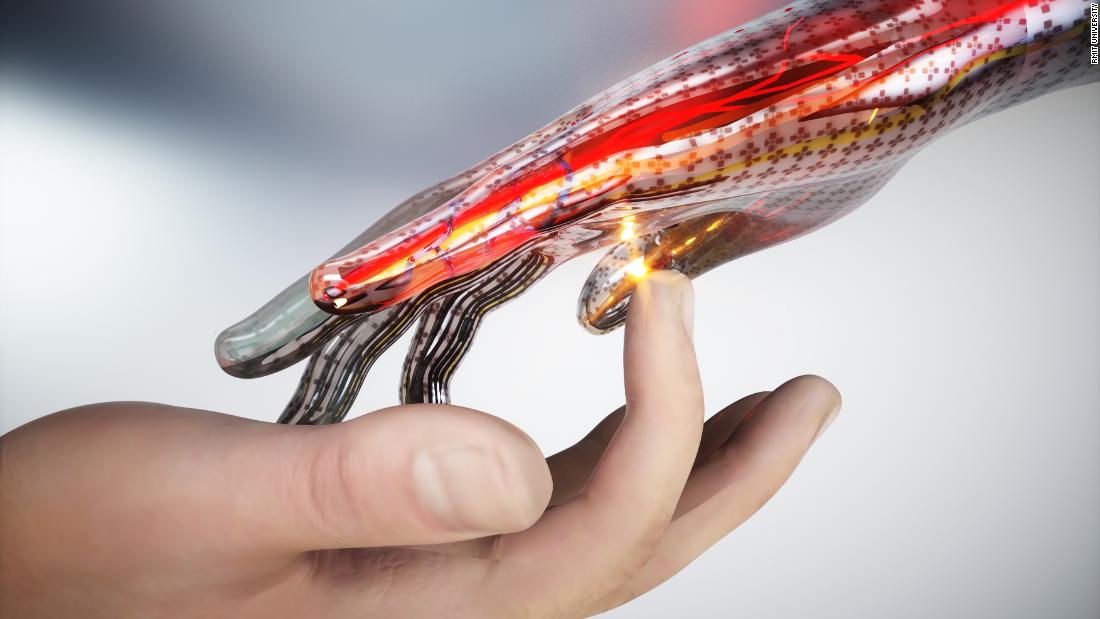
[ad_1]
The skin – the largest organ in the body – constantly monitors pain. It can automatically trigger actions to avoid pain by reflexes, such as when we touch something dangerously hot.
Now, researchers at RMIT University in Melbourne, Australia, have created artificial skin that mimics this mechanism and responds to pain stimuli.
Made of silicone rubber, it has the texture of real skin and is also “very similar to skin in its mechanical properties,” says Madhu Bhaskaran, an engineering professor at RMIT University and the project’s principal investigator.
This could lead to revolutionary innovations in prosthetics and robotics.
A quick answer
Much like real skin, the artificial version is designed to respond when pressure, heat or cold exceeds a pain threshold. Its outer layers sandwich electronic circuits dotted with sensors, which respond to stimuli.
“What’s fascinating about our body is that it works by sending electrical signals through a central nervous system,” Bhaskaran says. Electronic circuits work the same way and are just as fast, she explains.
When we touch something hot, the pain receptors in our skin send an electrical signal through our nerves to the brain. The brain sends its own electrical signal to initiate a response – such as a withdrawal reflex to move the affected limb away from heat.
Likewise, when one of the artificial skin’s sensors detects a pain stimulus, it sends an electrical signal to parts of the structure that mimic the brain, Bhaskaran says. This can be programmed to trigger movement.
“The key here is the thresholds,” Bhaskaran says. She explains that although we constantly feel stimuli, we only react when the stimulus crosses a threshold, “like touching something very hot.” The brain and the skin compare the stimuli and identify those that are dangerous, she says. When creating the artificial skin, scientists set these thresholds for electronics mimicking the brain.
The result is artificial skin that can differentiate the soft touch of a pin or a painful stab.
Smart prosthetics
Artificial skin could help create smart prostheses covered with functional skin that responds to pain like human limbs, letting the wearer know if they are touching anything that could cause damage.
“We have come a long way with prosthetics, but the emphasis has been heavily on the motor actions that the prosthetic limb can perform,” says Bhaskaran. Because conventional artificial limbs have no skin, they do not sense external dangers. “Having a skin-like layer would make it a lot more realistic,” she says.
Steve Collins, an expert in prosthetics and exoskeletons at Stanford University in the United States, who is not involved in the project, agrees: “When a person loses part of their limb by amputation, they lose. not only bones and muscles but also somatosensory organs. He said, referring to the organs that provide sensations like heat or pressure. While structure and movement have received a lot of attention in prosthetic design, sensing may be the key to achieving human-like performance with artificial limbs, he says.
Peter Kyberd, professor of engineering at the University of Portsmouth who created the world’s first microprocessor-controlled prosthetic limb in 1998, says he finds the work interesting: “Most of the current attempts to provide commentary on prosthetics to the user have not resulted in any improvement in day-to-day functioning, ”he says. Much of the problem is that “the type and quality of the feedback signals are very bad,” he says, adding that there is a long way to go before skin can be used routinely in prosthetics.
Artificial skin also has the potential to be used for skin grafts, Bhaskaran says. Artificial grafting could be a temporary measure that will eventually be replaced with real skin, or could be applied as a permanent graft when using real skin is not viable. The skin could also be used to create smart surgical gloves – replacing the sensitivity that is typically lost when wearing hand covers.
The most forward-thinking of all applications is robotics, where pain-sensitive artificial skin would not only provide realistic functionality, but also give a potential humanoid robot the ability to feel pain – an intriguing step forward not only on the technological level, but also philosophical.
Bhaskaran says the idea has potential, but it focuses on more immediate goals: “For now, we need to work closely with biomedical researchers to see how we can take the next step. the goal is to make it much more realistic and to integrate it. in real applications. “
[ad_2]
Source link